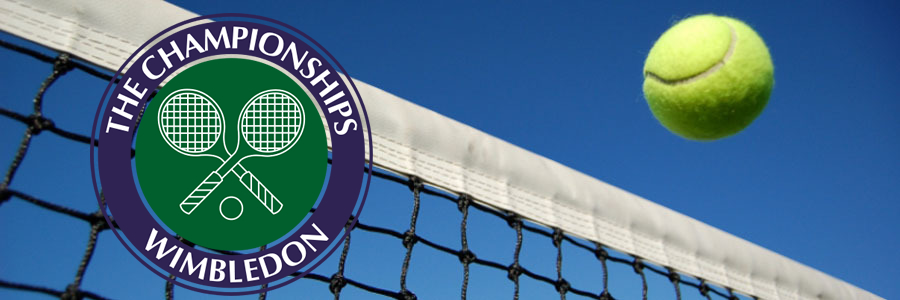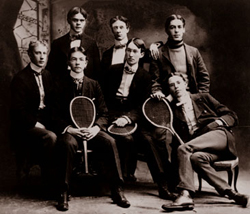




There are, of course, many other theories on the history of tennis. Roger Morgan's book 'Tennis, The development of the European ball game is another source of information and conflicts with the above theories.
The forward, written by H.R.H. Prince Edward, himself a keen Real Tennis player, says "Many myths and inaccuracies are dispelled; chief among these that tennis owes its origins to the monasteries of France."
Morgan also says that the origins were from a ball game played in the streets during the Middle Ages, which is a nice idea, but as the streets were also used as sewers, I don't think it would have been much fun, so I shall stick to the more romantic 'monasteries' theory for the time being.
Perhaps in the future I shall devote some space to the various other conflicting theories.
Fortunately, I have just received a copy of "THE TRUE ORIGINS OF ROYAL TENNIS" from a correspondent in Australia. I would urge you to read this in order to reach a decision on the subject. AUG DE JONG also has a very interesting account of The History of tennis in the Netherlands, which is certainly worth reading.
 Originally the game was played with the bare hand, later with a glove, then someone had the bright idea of attaching cord or tendons to the fingers.
Originally the game was played with the bare hand, later with a glove, then someone had the bright idea of attaching cord or tendons to the fingers.
It was a short step to attaching these cords to a frame and adding a handle to form a racket.
Today Grays of Cambridge are the only Real Tennis racket makers. The ball although similar in appearance to a lawn tennis ball is made with a core of cork, covered in cloth, tightly bound in string and covered in felt. The balls are all hand stitched and last for about 2 weeks.
This method has been used throughout history, although other substances such as hair or wool were used for the centre, and the balls were a good deal lighter (1oz as opposed to nearly 3oz), before the advent of the racket.
The modern version of the game is virtually indistinguishable from the 16th century version, indeed the actual court that Charles I built at Hampton Court in 1625, is still used for championship play today. Visitors to Hampton Court Palace can view the Real Tennis court.
The 16th and 17th centuries were a golden age for Real Tennis, it was played by the nobility throughout England and France. There were reputably as many as 1800 courts in Paris during the game's heyday, although many of these were probably quite rough structures.
It is even recorded that a court was built on a 2,000 ton French ship in the 16th century. The court at Versailles was built in 1686 at a cost of 45,403 Francs. By the 1700's the game had began to decline.
Almost 100 years later, The ‘Serment du Jeu de paulme’ (oath of the Real Tennis court) was signed in the Real Tennis court at Versailles on the 20th June 1789.
The court at Versailles is now a museum (see image). 11 months earlier on 21st July 1788, in Vizille castle’s "real tennis" room, the assembly of the three orders of the Dauphiné held the meeting that gave birth to the revolutionary process, It contains today the museum of the French Revolution. By 1800, partly due to the Revolution the game in France was practically non existent.
In England in the Tudor and Stuart periods tennis flourished, Henry VII loved the game and his successor Henry VIII was an accomplished player and had the original court at Hampton Court Palace built.
Sadly he was an addicted gambler and many of his financial problems were due to his massive wagers on the Real Tennis court.
James I lost his life due to Real Tennis, as he tried to evade his assassins by hiding down the drains his path was blocked by Real Tennis balls! Charles I and Charles II both enjoyed the game and tennis thrived during this period, apart from some awkwardness between their reigns.
Like France, the 18th century saw a decline in the game of Real Tennis, although some courts were built in this period. An example of this was the court built in Bath in 1777. Sadly this court was used for only 37 years, but the building still survives as the Bath Industrial Heritage Centre.
 In the mid 19th century there was a revival of the game and a flurry of court construction, primarily as additions to estates, most of the courts in use today are products of this period.
In the mid 19th century there was a revival of the game and a flurry of court construction, primarily as additions to estates, most of the courts in use today are products of this period.
The first courts in the USA and Australia were built in 1876 and 1882 respectively. The first World War cast a deep shadow over the game from which it has only just began to emerge.
The current state of play is : Australia - 4 active courts (with new courts planned), France - 3, the UK 19, (new courts have recently been built at The Oratory School and the Harbour Club in London
The Dutch Real Tennis Association have hopes to build a Real Tennis court in The Hague.
Even the Russians have plans to restore the Real Tennis court in St. Petersburg. Apparently the court, which was built around the 1790's, is now a gym.
There are a small group of devotees keen to get the court going again, including Prince Nicholas Galitzine (I didn't know that there were any Russian prince's left).
Judging by the amount of email from different parts of the world (including Moscow! but not St.P) that I have received already from this site, I would suspect that Real Tennis really is growing in popularity.